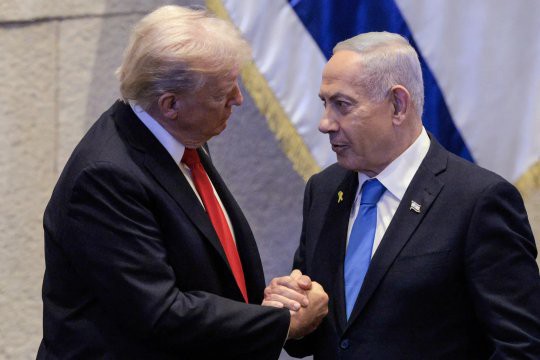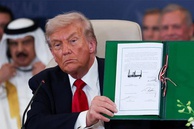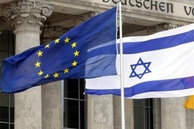Israel and Hamas have begun implementing the first phase of the Gaza peace plan prepared by the Donald Trump administration. The participants in a summit in Sharm el-Sheikh announced the end of the war in Gaza and the achievement of "eternal peace." There is a general sense of euphoria now reigning in the Middle East, although similar feelings were prevalent there in 1994 when Yasser Arafat, Shimon Peres and Yitzhak Rabin were awarded the Nobel Peace Prize for their efforts to achieve peace in the region. What are the long-term prospects now?
In late September, Trump presented a multi-stage plan to end the war between Israel and Hamas, which had been ongoing since October 2023. Its first phase includes a ceasefire, the exchange of Israeli hostages for Palestinian prisoners within a set timeframe, and the withdrawal of Israeli troops to agreed-upon lines. On October 3, Hamas representatives agreed to support Trump's plan, at least its initial phase. On October 6, representatives of the Jewish state and the Palestinian group held indirect talks in Egypt. With mediation by the United States, represented by special envoy Steve Whitkoff and President Trump’s son-in-law Jared Kushner, along with diplomats from Egypt, Qatar, and Turkey, the sides agreed on priority measures to halt hostilities and exchange hostages.
According to Western media reports, the settlement plan presented by the Trump administration is a result of intense diplomatic pressure from Qatar, Saudi Arabia, and several other Arab and Muslim states. Vexed by the September 9 Israeli strike on Qatar's capital, Trump, "partially changed" his view on the Israel-Hamas confrontation and ramped up pressure on Netanyahu. Besides the release of Israeli hostages, the plan’s main message is to solidify Trump's role as a key mediator in the normalization process between Israel and Saudi Arabia. Sources also emphasize that Trump deliberately proclaimed the peace deal right before the Nobel committee was to name the winner of this year’s Peace Prize.
On October 9, Trump and Hamas representatives confirmed the agreement, noting that it would "end the war in Gaza," "ensure a full withdrawal" of Israeli troops, and lead to the resumption of humanitarian aid deliveries to Gaza. By October 10, the Israeli government and parliament had supported the agreement. On Friday, Israeli troops started withdrawing to the Gaza border. On October 13, Hamas released all hostages. On the same day, Trump arrived in the Middle East, visiting Israel before moving on to Sharm el-Sheikh in Egypt to attend a "peace summit" by leaders from over 20 countries, including Britain, Qatar, the Palestinian Authority, Turkey, and France. Following the summit, the leaders of Egypt, Qatar, the United States and Turkey signed a document on ending the conflict in the Gaza Strip.
This sent a wave of jubilation across Israel, the Palestinian territories, and the countries involved in the negotiations. Photos made in Egypt show Israeli and Qatari negotiators embracing – something previously unimaginable, given the recent weeks of tension between the countries. Nevertheless, apart from the already agreed ceasefire and the exchange of hostages for Palestinian prisoners, the remaining points of Trump's plan will likely require lengthy and intense negotiation.
According to the plan, Hamas must disarm in exchange for its members being amnestied and allowed to safely leave Gaza. All authority in Gaza will be handed over to a technocratic administration, excluding Hamas representatives, under the supervision of an international transitional body headed by Trump. The Israeli army will be pulling out from Gaza in several stages, reassigning security responsibilities to international forces and Palestinian police. On October 12, US Vice President J.D. Vance stated that American troops would help monitor the parties’ adherence to the truce. Speaking at a news conference after the Sharm el-Sheikh summit, Egyptian President Abdel Fattah el-Sisi declared that the agreement signed by the four countries "...will lead to the implementation of a solution for the peaceful coexistence of two states: Israeli and Palestinian." i This is a very significant statement.
However, neither Netanyahu, who declined to come to Egypt, formally citing the start of the Simchat Torah holiday, not Hamas representatives were present among the signatories of the agreement. Moreover, Palestinian militants have not yet agreed to one of the two key conditions of Trump's proposal: complete disarmament. Hamas, designated a terrorist organization by the US and the European Union, has yet to make an official statement about withdrawing from Gaza's political arena. On October 9, its representative told the Qatari TV channel Al Jazeera that they were ready to not participate in the governance of the sector, admitting the need for "necessary flexibility" on this issue. However, by October 13, reports started coming in about Hamas already fighting again – this time with rival Palestinian groups.
Trump's proposal also states that the Palestinian Authority (PA), which governs parts of the occupied West Bank, will only participate in running Gaza once a reform program has been completed. However, on October 4, foreign ministers of eight Middle Eastern countries issued a joint statement where, while welcoming the steps taken by Israel and Hamas towards a ceasefire, they emphasized that the PA should control the situation in the Gaza Strip.
The future political structure of the Palestinian territories could become a sticking point, just as it has many times before. Israeli tanks and aviation have razed Gaza's cities and destroyed the sector’s infrastructure. The number of residents killed there runs into tens of thousands, and hundreds of thousands have become refugees. At the same time, Trump’s plan is rather vague on this issue, and Netanyahu has repeatedly stated that the idea of creating a Palestinian state is unacceptable to him. Furthermore, several members of his cabinet would like to annex Gaza. Hamas, in turn, directly conditions its readiness to disarm on the establishment of a state for Palestinian Arabs.
In late September, The Economist wrote that the issue of a Palestinian state once again hinges on political will and motivation. A Pew Research Center survey conducted earlier this year showed that only 21 percent of Israelis believe their country can peacefully coexist with a Palestinian state. Almost two-thirds of Palestinian respondents said that a two-state solution no longer seems possible. Therefore, the British magazine concludes, most Israelis and Palestinians consider this either impossible or undesirable.
Secondly, this is the question of motivation: neither side, especially Israelis, believes in the seriousness of international intentions to achieve a settlement. In private conversations, Arab leaders assert that Israel faces a choice either to accept a plan for regional peace and integration or isolate itself by engaging in war and annexation. They have not publicly clarified this dilemma for Israelis though, thus allowing Netanyahu's government to claim it is false. The same applies to Europe. Most EU members now recognize Palestine, but if their statements are not backed by concrete actions, Israel could dismiss them as just empty rhetoric.
Overall, the main risk of substituting long-term agreements with short-term ones is that their stated goals fundamentally contradict each other. Sustainable development is inseparable from a long-term strategic vision, whereas short-term agreements are focused on immediate results in the form of a one-off transaction. "Deal"-like agreements aim to quickly alleviate current negative aspects without providing guarantees for their long-term elimination. By contrast, building promising relationships requires comprehensive analysis and the ability for strategic forecasting.
Even more so, this applies to international treaties, which form the bedrock of interstate relations. Replacing full-fledged international legal mechanisms with unstructured short-term deals leads to the establishment of an unstable and declarative pseudo-peace. Thus, it is crucial to distinguish between deals that merely postpone the resolution of systemic problems and treaties aimed at their comprehensive settlement. A transactional approach creates an illusion of progress, deferring resolution of conflicts to an indefinite future and failing to provide conditions for lasting peace. As a result, a rushed and ill-conceived negotiation process will eventually necessitate a review of its outcomes.
The vulnerabilities of Trump's plan are evident. There is a serious risk that any agreement between the Israeli government led by Netanyahu and the Hamas movement could be concluded without genuine commitment by the signatories, whose strategic goal might be to subsequently prevent it from happening. The details concerning the sequence of realizing the agreements will require careful and complex coordination and are highly susceptible to potential destabilizing actions from both sides.
The prospects for the reconstruction of the Gaza Strip look problematic both from the standpoint of organizational capacity and financial feasibility. The current political dynamics inside Israel could potentially encourage the country’s present or future leadership to denounce the agreement and move towards the annexation of Palestinian territories.
In turn, the PA's institutional capacity to implement the necessary reforms is not evident, which creates a risk of temporary administrative mechanisms functioning beyond any objectively justified period. Furthermore, despite the UN rhetoric, empirical data suggests that the two-state idea is not very popular among the majority of Israelis and Palestinians.
Does the current truce guarantee an end to the war? Trump is convinced that the hostage deal also means that the war is over. The problem now is how to implement the US President's twenty-point plan, which requires the disarmament of Hamas, the creation of international security forces, and new governance structures in the Gaza Strip that exclude Hamas. Further progress will demand constant pressure from Trump on Israel, as well as from Arab countries and Turkey on Hamas.
As for the long-term settlement of the Arab-Israeli conflict, formally, Trump's plan does not rule out the creation of a Palestinian state. At the same time, the plan contains conditions, some of which either Hamas or Israel may find hard to accept. Thus, even if Israel and Hamas make progress on the initial points of the plan, whether the current agreements will lead to lasting peace remains anyone’s guess.
-----------------------------------------------------
https://ria.ru/20251013/gaza-2048058417.html
read more in our Telegram-channel https://t.me/The_International_Affairs

 16:11 14.10.2025 •
16:11 14.10.2025 •



























